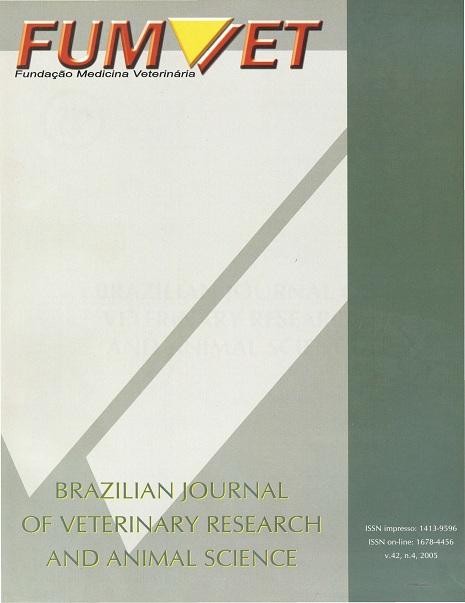Use of hCG, GnRH or 17²-estradiol and progesterone associated with melengestrol acetate and prostaglandin F2± in cross-bred heifers (Bos taurus indicus x Bos taurus taurus)
DOI:
https://doi.org/10.11606/issn.1678-4456.bjvras.2005.26417Keywords:
Estrus, Synchronization, Telemetry, Melengestrol acetate, ProstaglandinsAbstract
Objectives of the present experiment were to evaluate the reproductive performance and estrus characteristics in cross-bred beef heifers (Bos taurus indicus x Bos taurus taurus) treated with a MGA/prostaglandin (PG) protocol in association with other hormones. On day 0 (Day 0 = beginning of MGA intake), heifers were randomly allocated to receive 2mL saline solution (Saline group), 2500IU hCG (hCG group), 20µg buserelin acetate (GnRH group) or 5mg 17²-estradiol + 100mg progesterone (E2-17²+P4 group). Blood samples were obtained at days - 7, 0, 7 and 10 to evaluate progesterone plasma concentrations. Heifers from all groups received 0,5mg MGA/animal/day from days 0 to 7 and PG (Day 7). Heifers were observed for heat for 120h using the "Heat-Watch" system, starting immediately after the PG injection. Heifers were inseminated 12 hours after observed heat or timed inseminated 72 hours after PG injection. Pregnancy diagnosis was performed 35 days after insemination by transrectal ultrasonography. Estrus response in each group was 50,0%, 22,2%, 59,5% and 71,8% for Saline, hCG, GnRH and E2-17²+P4 groups respectively (P<0,01). Average interval from PG to estrus was 72,8 ± 22,2, 102,0 ± 22,7, 84,6 ± 19,0 and 72,5 ± 24,4 hours (P<0,01) and the degree of synchronization was similar among groups. Conception rates were 57,9%, 37,5%, 40,9% and 39,3%, and pregnancy rates were 29,0%, 11,1%, 27,0% and 28,2% respectively, for Saline, hCG, GnRH and E2-17²+P4 groups. There was no treatment effect on estrus duration (10,4 ± 5,7 hours), number of mounts (23,0 ± 16,9), and duration of mounts (2,7 ± 0,3 seconds). Values in parenthesis represent pooled mean ± standard error for each variable. In conclusion, reproductive performance was not altered by adding hCG, GnRH or E2-17²+P4 to the MGA/PG synchronization protocol.Downloads
Downloads
Published
2005-08-01
Issue
Section
UNDEFINIED
License
The journal content is authorized under the Creative Commons BY-NC-SA license (summary of the license: https://
How to Cite
1.
Binelli M, Rodrigues PHM, Celeguini ECC, Almeida AB de, Rossa LAF, Baruselli PS, et al. Use of hCG, GnRH or 17²-estradiol and progesterone associated with melengestrol acetate and prostaglandin F2± in cross-bred heifers (Bos taurus indicus x Bos taurus taurus). Braz. J. Vet. Res. Anim. Sci. [Internet]. 2005 Aug. 1 [cited 2025 Apr. 6];42(4):237-49. Available from: https://www.revistas.usp.br/bjvras/article/view/26417





